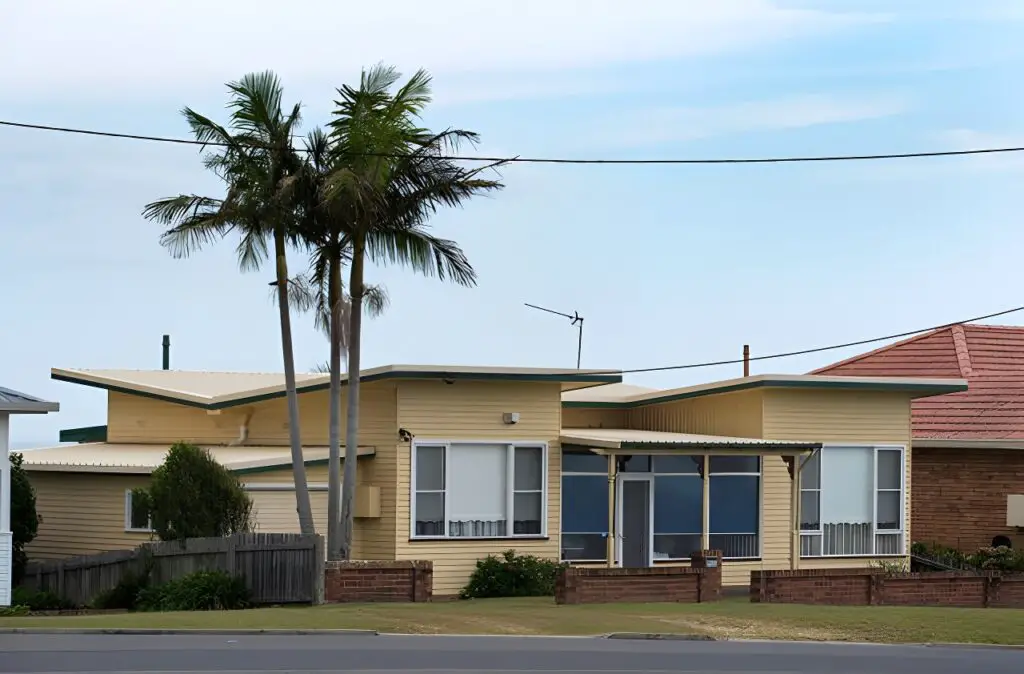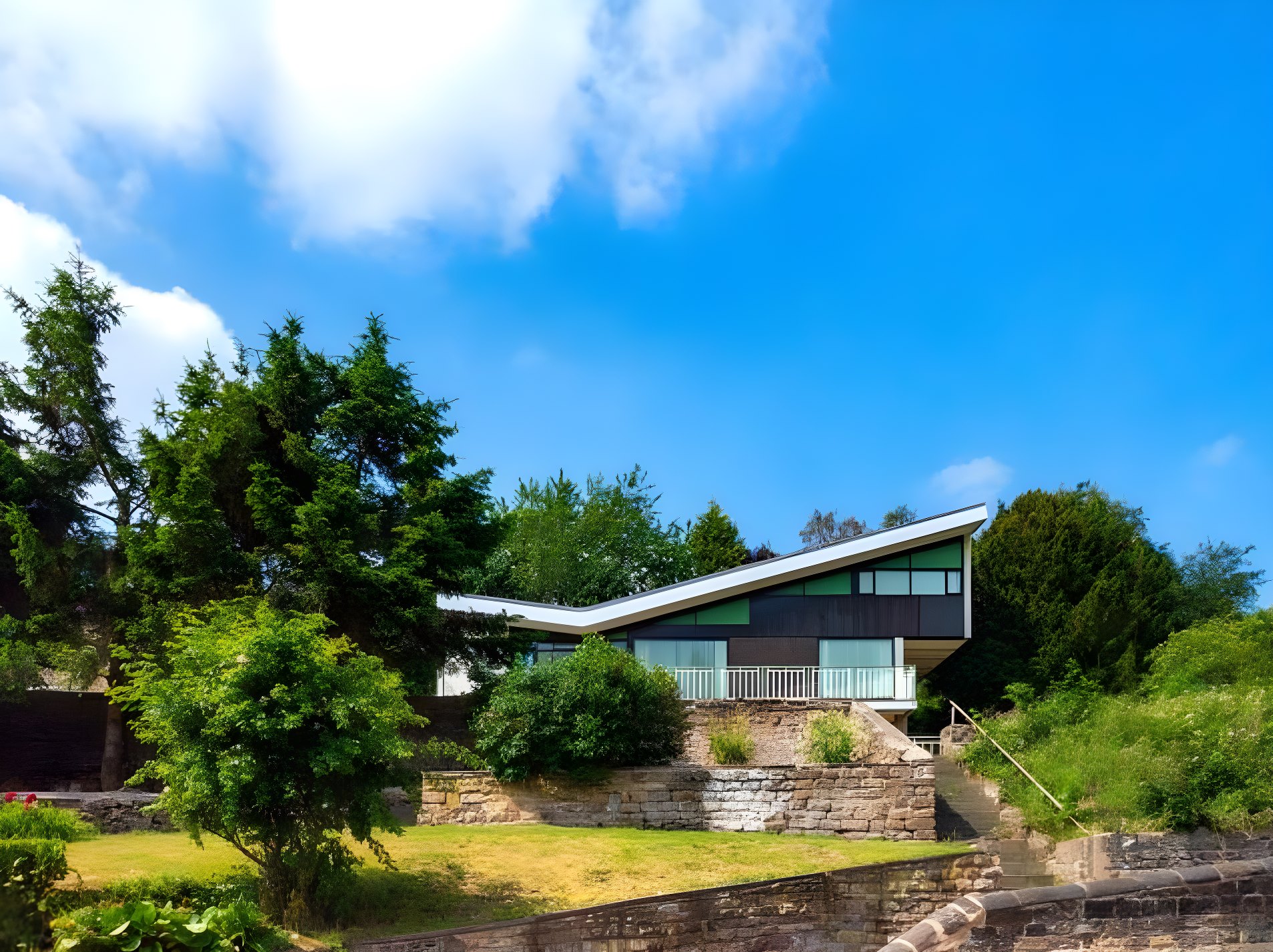Last Updated on: 23rd December 2022, 08:33 am
A butterfly roof (also known as the V-roof) is a type of roof that has two sides that slope downward from opposite ends and meet in the middle. It is actually an inverted gable roof, whose V-shape resembles that of two lifted wings. Butterfly roofs were popularized heavily by architect William Krisel in California during the 1950s modernist movement. This innovative roof structure features two symmetrical gables with a central ridge, creating the “butterfly” silhouette. The design is particularly well-suited to areas with plentiful rainfall, as the sloping roof helps to efficiently channel water away from the structure. In addition, butterfly roofs also maximize air circulation and natural light to the interior of the building.
It can be used as a standalone structural system for a variety of design typologies, from independent houses to buses. It is easily identified and its silhoette offers a visually striking alternative to traditional roof designs. As an eyecatching and iconic design element, butterfly roofs are frequently used as a statement piece to add a unique and timeless aesthetic to buildings.
Pros and Cons of Butterfly Roof Design
Despite its aesthetic advantages, thi sroof style also holds a variety of pros and cons, making it important to weigh the advantages and disadvantages when considering this type of roof for your home.
Advantages of the butterfly roof include their ability to provide an expansive view, their ability to collect rainwater, and their potential for providing natural ventilation. On the other hand, there are also some drawbacks associated with this design, such as the need for additional supportt beams and the difficulty in insulatign and waterproofing such a roof.
Before selecting a butterfly roof for your home, it is important to understand the pros and cons associate with this design. Doing so can help you make an educated decision on whether or not a butterfly roof is best for your home.
Benefits of Butterfly Roofs
A butterfly roof offers many benefits to homeowers and architects alike. Its inverted V-shape provides a unique esthetic quality to a home´s exterior that is both visually striking and modern. Furthermore, the V-shape allows for rainwater to be collected and diverted away from the structure, making it an ideal choice for climates that experience heavy precipitation. Also, the shape of the roof provides the opportunity for natural ventilation in warm climtates, as hot air can easily escape through the elevated sides of the roof. A butterfly roof can also be used as a standalone system for independent houses or other structures, providing a visually appealing and functional roof solution. Finally, butterflyroofs are relatively easy and cost effective to construct, making them an attractive option for homeowners looking to renovate orbuild their own home.

Materials for Constructing a Butterfly Roof
As far as materials for constructing a butterfly roof, many different types can be used, each with their own benefits and drawbacks. Common materials include concrete, steel, wood, clay tiles, and asphalt shingles. Concrete is a long-lasting and lowmaintenance option, however it can be quite heavy and expensive. Steel provides a durable and lightweight option that is also relativel inexpensive, but it may require extra insulation to protect against temperature fluctuations. It can also be recycled and reused at the end of its lifespan. However, both materials require regular maintenance to ensure optimal performance. Steel is susceptible to corrosion andwood is vulnerable to rot and pests, so it´s important to consider the environment in which your butterfly roof will be installed when deciding which material to use. On top of that, steel is more expensive than wood and requires more specialized tools and labor to install, while wood is easier to work with and more affordable. Wood can provide a natural aesthetic, but it requires regular maintenance to keep it looking its best. Clay tiles or asphalt shingles provide an attractive option that is also affordable, though they may not be as long-lasting as other materials. Ultimately, the best material for your butterfly roof will depend on your individual needs and budget. Ultimately, it´s up to you to weigh the pros and cons of each material when selecting which one is right for your project.
Strategies for Rainwater Management with a Butterfly Roof Design
Rainwater management is an important consideration when designing a butterfly roof. Due to its unique shape, rainwater runoff is much more difficulto manage than with traditional gable roofs. To ensure proper drainage and avoid water pooling, it is important to consider the slope of the roof, the size and number of downspouts, and the use of gutters. Slope should be designed carefully to ensure thatwater is directed away from the building´s foundation and into drainage channels or away from the structure. The size and numnber of downspouts should be calculated based on the amount of rainfall anticipated in your area, as well as the size of the roof. Gutters can be used to collect and direct water away from the building, but they must be properly sized and installed in order to avoid clogging or overflowing. Properly sized and installed gutters will also help to prevent water damage to walls and windows. Also, it is important to considerhow you will manage overflow from your gutters during times of heavyrain or when snow melts. Properly designed and installed rainwater management systems are essential for protecting your butterfly roof design from water damage.
Tips for Insulating Your Butterfly Roof Design
Insulation is an important consideration for any roof design, including the butterfly roof. To ensure that your butterfly roof design is adequately insulated, there are several strategies you can take. The most common insulatio technique is using a spray foam insulation system. This system will provide a layer of insulation between the roof and the interior of the home, helping to keep the house cool in the summer and warm in the winter. Moreover, an insulation blanket can be installed under the roofing material to provide an additional layer of insulation. This will helpto reduce energy costs and create a more comfortable environment inside the home. When insulating a butterfly roof design, it is important to consider the structure of the roof and how it affects the flow of air. Properly sealing all seams and gaps will help to reduce air leakage and keep your home at the desired temperature all year round.
How to Utilize Natural Ventilation with a Butterfly Roof Design
One the benefit of a butterfly roof is the ability to naturally ventilate a home. This is due to the fact that the V-shaped wings of the butterfly roof create an area of low pressure which allows for hot air to escape the home. To further take advantageof this natural ventilaton it is important to ensure that all operable windows are open and that the roof line is not obstructed by any other structures in order to maximize airflow. Additionally, adding an attic fan or roof vent can be beneficial in order to assist with ventilation and reduce heat build-up within the home. In warmer climates, it may also be beneficial to install an operable skylight in order to allow hot air to escape during the day. With these simple strategies, homeowners canmake use of natural ventilation to keep their homes cool and comfortable all year long.
Incorporating Sustainable Energy Practices into Your Butterfly Roof Design
A butterfly roof is a popular design choice for homeowners looking to incorporate sustainable energy practices into their home. This type of roof is designed to capture and retain solar energy, making it easier to heat and cooly your home while reducing your energy bills. Furthermore, the design of the roof allows for natural ventilation and increased air circulation, reducing the need for air conditoning and further lowering your energy costs. To optimize the sustainability of your butterfly roof, you can add solar panels to capture the maximum amount of light and install a rainwater harvesting system to reduce your water consumption. Additionally, you can use green building materials such as bamboo to reduce your impact on the environment. By implementing these sustainable practices, you can make your butterfly roof design more efficient and environmentally friendly.
Enhancing Aesthetics with Decorative Elements on Your Butterfly Roof
Adding decorative elements to your butterfly roof design can give it a unque and visually appealing appearance. Small details such as decorative trim, window boxes, or cornices and eavescan help to enhance the overall look of the roof. Alsdo, painting the roof in a bright color or using a patterned finish can create a stunning effect. For example, a monotone white finish cangive the roof a sleek and minimalis t appearance, while a patterned finish can add some visual interest.
Adding lighting fixtures or decorative accents can further enhance the look of your butterfly roof design. These elements can also be used to highlight certain ares of the roof such as its peaks or valleys. Furthermore, they can provide additional lighting in areas where it may be needed. Investing in quality materials and taking the time to carefully select decorative elements that complement the design of your butterfly roof will guarantee stunning results.
